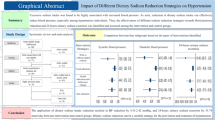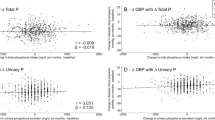Abstract
Background/objectives
In addition to weight-loss, healthy dietary patterns and lower sodium intakes can help reduce blood pressure (BP), but individualised dietary advice may be necessary to achieve these effects. This study aimed to examine the impact of individualised dietary advice on BP in the intensive phase of a weight-loss trial.
Subjects/methods
Secondary analysis of baseline and 3-month data from the HealthTrack randomised controlled trial (n = 211). Participants were randomly assigned to one of three dietary advice groups: general advice (control), individualised advice (intervention group, I), or intervention group supplemented with 30 g walnuts/day (IW). Resting BP and 24-h urine sodium and potassium were measured. Dietary intake was evaluated through diet history interviews.
Results
Unadjusted SBP reduced significantly in all groups (IW and I groups P < 0.001; control group P = 0.002) and DBP in IW and I groups (P < 0.001). Compared to controls, the reductions in BP were 3–4 mmHg greater in the I and IW groups, but this only reached significance for DBP in the I group (−3.3 mmHg; P = 0.041). After controlling for age, sex, medication, weight-loss, physical activity and smoking, only the IW group showed a significant association between SBP reduction and increased urinary potassium (β = −0.101, P = 0.044), decreased sodium:potassium ratio (β = 2.446, P = 0.037) and increased consumption of seed and nut products and dishes (β = −0.108, P = 0.034).
Conclusions
Dietary patterns with distinctive foods and lower sodium:potassium ratios may enhance the effects of weight-loss on BP. The patterns were best achieved with individualised dietary advice and food supplements.
This is a preview of subscription content, access via your institution
Access options
Subscribe to this journal
Receive 12 print issues and online access
$259.00 per year
only $21.58 per issue
Buy this article
- Purchase on Springer Link
- Instant access to full article PDF
Prices may be subject to local taxes which are calculated during checkout


Similar content being viewed by others
References
Lim SS, Vos T, Flaxman AD, Danaei G, Shibuya K, Adair-Rohani H, et al. A comparative risk assessment of burden of disease and injury attributable to 67 risk factors and risk factor clusters in 21 regions, 1990-2010: a systematic analysis for the Global Burden of Disease Study 2010. Lancet. 2012;380:2224–60.
Law MR, Morris JK, Wald NJ. Use of blood pressure lowering drugs in the prevention of cardiovascular disease: meta-analysis of 147 randomised trials in the context of expectations from prospective epidemiological studies. BMJ. 2009;338:b1665–b1665.
Eckel RH, Jakicic JM, Ard JD, De Jesus JM, Houston Miller N, Hubbard VS. et al. 2013 AHA/ACC guideline on lifestyle management to reduce cardiovascular risk: a report of the American College of cardiology/American Heart Association task force on practice guidelines. Circulation. 2014;129:S76–S99.
He FJ, Li J, Macgregor GA. Effect of longer-term modest salt reduction on blood pressure. Cochrane Database Syst Rev. 2013;4:CD004937.
Geleijnse JM, Kok FJ, Grobbee DE. Blood pressure response to changes in sodium and potassium intake: a metaregression analysis of randomised trials. J Hum Hypertens. 2003;17:471–80.
Perez V, Chang ET. Sodium-to-potassium ratio and blood pressure, hypertension, and related factors. Adv Nutr. 2014;5:712–41.
Neter JE, Stam BE, Kok FJ, Grobbee DE, Geleijnse JM. Influence of weight reduction on blood pressure: a meta-analysis of randomized controlled trials. Hypertension. 2003;42:878–84.
Rocchini AP. Obesity hypertension. Am J Hypertens. 2002;15:50S–52S.
Joshy G, Korda RJ, Attia J, Liu B, Bauman AE, Banks E. Body mass index and incident hospitalisation for cardiovascular disease in 158 546 participants from the 45 and up Study. Int J Obes. 2014;38:848–56.
Miura K, Greenland P, Stamler J, Liu K, Daviglus ML, Nakagawa H. Relation of vegetable, fruit, and meat intake to 7-year blood pressure change in middle-aged men: the Chicago Western Electric Study. Am J Epidemiol. 2004;159:572–80.
Engberink MF, Hendriksen MAH, Schouten EG, van Rooij FJA, Hofman A, Witteman JCM, et al. Inverse association between dairy intake and hypertension: the Rotterdam Study. Am J Clin Nutr. 2009;89:1877–83.
Umesawa M, Kitamura A, Kiyama M, Okada T, Shimizu Y, Imano H, et al. Association between dietary behavior and risk of hypertension among Japanese male workers. Hypertens Res. 2013;36:374–80.
Zhou D, Yu H, He F, Reilly KH, Zhang J, Li S, et al. Nut consumption in relation to cardiovascular disease risk and type 2 diabetes: a systematic review and meta-analysis of prospective studies. Am J Clin Nutr. 2014;100:270–7.
Mozaffari-Khosravi H, Ahadi Z, Barzegar K. The effect of green tea and sour tea on blood pressure of patients with type 2diabetes: a randomized clinical trial. J Diet Suppl. 2013;10:105–15.
Steffen M, Kuhle C, Hensrud D, Erwin PJ, Murad MH. The effect of coffee consumption on blood pressure and the development of hypertension: A systematic review and meta-analysis. J Hypertens. 2012;30:2245–54.
Michels KB, Schulze MB. Can dietary patterns help us detect diet-disease associations? Nutr Res Rev. 2005;18:241–8.
Hu FB. Dietary pattern analysis: a new direction in nutritional epidemiology. Curr Opin Lipidol. 2002;13:3–9.
Appel LJ, Moore TJ, Obarzanek E, Vollmer WM, Svetkey LP, Sacks FM, et al. A clinical trial of the effects of dietary patterns on blood pressure. N Eng J Med. 1997;336:1117–24.
Toledo E, Hu FB, Estruch R, Buil-Cosiales P, Corella D, Salas-Salvadó J, et al. Effect of the Mediterranean diet on blood pressure in the PREDIMED trial: results from a randomized controlled trial. BMC Med. 2013;11:207.
Brader L, Uusitupa M, Dragsted LO, Hermansen K. Effects of an isocaloric healthy Nordic diet on ambulatory blood pressure in metabolic syndrome: a randomized SYSDIET sub-study. Eur J Clin Nutr. 2014;68:57–63.
National Health and Medical Research Council. Australian Dietary Guidelines. Canberra: National Health and Medical Research Council; 2013.
Tapsell LC, Lonergan M, Martin A, Batterham MJ, Neale EP. Interdisciplinary lifestyle intervention for weight management in a community population (HealthTrack study): study design and baseline sample characteristics. Contemp Clin Trials. 2015;45:394–403.
Tapsell LC, Lonergan M, Batterham MJ, Neale EP, Martin A, Thorne R. et al. Effect of interdisciplinary care on weight loss: a randomised controlled trial. BMJ Open. 2017;7:e014533
McLean RM. Measuring population sodium intake: a review of methods. Nutrients. 2014;6:4651–62.
Murakami K, Livingstone MBE, Sasaki S, Uenishi K. Ability of self-reported estimates of dietary sodium, potassium and protein to detect an association with general and abdominal obesity: comparison with the estimates derived from 24’ h urinary excretion. Br J Nutr. 2015;113:1308–18.
Campins Falcó P, Tortajada Genaro LA, Meseger Lloret S, Blasco Gomez F, Sevillano Cabeza A, Molins Legua C. Creatinine determination in urine samples by batchwise kinetic procedure and flow injection analysis using the Jaffé reaction: chemometric study. Talanta. 2001;55:1079–89.
Reinivuo H, Valsta LM, Laatikainen T, Tuomilehto J, Pietinen P. Sodium in the Finnish diet: II trends in dietary sodium intake and comparison between intake and 24-h excretion of sodium. Eur J Clin Nutr. 2006;60:1160–7.
Martin GS, Tapsell LC, Denmeade S, Batterham MJ. Relative validity of a diet history interview in an intervention trial manipulating dietary fat in the management of Type II diabetes mellitus. Prev Med. 2003;36:420–8.
Food Standards Australia and New Zealand. AUSNUT 2007—Australian food, supplement and nutrient database for estimation of population nutrient intakes. Canberra: Food Standards Australia New Zealand. 2008. http://www.foodstandards.gov.au/consumerinformation/ausnut2007/. Accessed 25 May 2015.
Food Standards Australia and New Zealand. AUSNUT 2011–13. Australian food, supplement and nutrient database for estimation of population nutrient intakes. Canberra: Food Standards Australia New Zealand. 2014. http://www.foodstandards.gov.au/science/monitoringnutrients/ausnut/ausnutdatafiles/Pages/default.aspx. Accessed 25 May 2015.
Neale EP, Probst YC, Tapsell LC. Development of a matching file of Australian food composition databases (AUSNUT 2007 to 2011-13). J Food Compos Anal. 2016;50:30–35.
Ndanuko RN, Tapsell LC, Charlton KE, Neale EP, Batterham MJ. Associations between dietary patterns and blood pressure in a clinical sample of overweight adults. J Acad Nutr Diet. 2017;117:228–39.
Craig CL, Marshall AL, Sjöström M, Bauman AE, Booth ML, Ainsworth BE, et al. International physical activity questionnaire: 12-country reliability and validity. Med Sci Sports Exerc. 2003;35:1381–95.
National Center for Health Statistics. The Third National Health and Nutrition Examination Survey Plan and Operations manuals. Hyattsville: Centres for Disease Control and Prevention; 1988. P.
Wile D. Diuretics: a review. Ann Clin Biochem. 2012;49:419–31.
Mohammadifard N, Salehi-Abargouei A, Salas-Salvadó J, Guasch-Ferré M, Humphries K, Sarrafzadegan N. The effect of tree nut, peanut, and soy nut consumption on blood pressure: a systematic review and meta-analysis of randomized controlled clinical trials. Am J Clin Nutr. 2015;101:966–82.
Tapsell LC, Neale EP, Satija A, Hu FB. Foods, nutrients, and dietary patterns: Interconnections and implications for dietary guidelines. Adv Nutr. 2016;7:445–54.
Zhang Z, Cogswell ME, Gillespie C, Fang J, Loustalot F, Dai S, et al. Association between usual sodium and potassium intake and blood pressure and hypertension among U.S. adults: NHANES 2005−2010. PLoS ONE. 2013;8:e75289.
Saneei P, Salehi-Abargouei A, Esmaillzadeh A, Azadbakht L. Influence of Dietary Approaches to Stop Hypertension (DASH) diet on blood pressure: a systematic review and meta-analysis on randomized controlled trials. Nutr, Metab Cardiovasc Dis. 2014;24:1253–61.
Adrogué HJ, Madias NE. Sodium and potassium in the pathogenesis of hypertension. N Engl J Med. 2007;356:1966–78.
Anil S, Charlton KE, Tapsell LC, Probst Y, Ndanuko R, Batterham MJ. Identification of dietary patterns associated with blood pressure in a sample of overweight Australian adults. J Hum Hypertens. 2016;30:672–8.
Esposito K, Marfella R, Ciotola M, Di Palo C, Giugliano F, Giugliano G, et al. Effect of a Mediterranean-style diet on endothelial dysfunction and markers of vascular inflammation in the metabolic syndrome: a randomized trial. JAMA. 2004;292:1440–6.
Doménech M, Roman P, Lapetra J, García De La Corte FJ, Sala-Vila A, De La Torre R, et al. Mediterranean diet reduces 24-hour ambulatory blood pressure, blood glucose, and lipids: one-year randomized, clinical trial. Hypertension. 2014;64:69–76.
Kendall CWC, Josse AR, Esfahani A, Jenkins DJA. Nuts, metabolic syndrome and diabetes. B J Nutr. 2010;104:465–73.
O’Neil CE, Nicklas TA, Fulgoni VL 3rd. Tree nut consumption is associated with better nutrient adequacy and diet quality in adults: National Health and Nutrition Examination Survey 2005-2010. Nutrients. 2015;7:595–607.
Ramel A, Martinez JA, Kiely M, Bandarra NM, Thorsdottir I. Moderate consumption of fatty fish reduces diastolic blood pressure in overweight and obese European young adults during energy restriction. Nutrition. 2010;26:168–74.
Appel LJ, Miller ER 3rd, Seidler AJ, Whelton PK. Does supplementation of diet with ‘fish oil’ reduce blood pressure? A meta-analysis of controlled clinical trials. Arch Intern Med. 1993;153:1429–38.
Yang B, Shi M-Q, Li Z-H, Yang J-J, Li D. Fish, long-chain n-3 PUFA and incidence of elevated blood pressure: a meta-analysis of prospective cohort studies. Nutrients. 2016;8:58–70.
Jacobs DR Jr., Gross MD, Tapsell LC. Food synergy: an operational concept for understanding nutrition. Am J Clin Nutr. 2009;89:1543S–1548S.
Liu K, Cooper R, McKeever J, Makeever P, Byington R, Soltero I, et al. Assessment of the association between habitual salt intake and high blood pressure: methodological problems. Am J Epidemiol. 1979;110:219–26.
Acknowledgements
The authors would like to thank all the investigators and participants of the HealthTrack study.
Funding
HealthTrack study was primarily funded by the Illawarra Health and Medical Research Institute with additional support from the California Walnut Commission. HealthTrack study was registered on the Australian New Zealand Clinical Trials Registry, trial ID ACTRN12614000581662 (www.anzctr.org.au).
Author contributions
LCT, KEC, EPN and MJB designed the research; RNN conducted the research; RNN and MJB performed the statistical analysis; RNN, LCT, KEC and EPN wrote the manuscript; RNN had primary responsibility for the final content. All authors read and approved the final manuscript.
Author information
Authors and Affiliations
Corresponding author
Ethics declarations
Conflict of interest
The authors declare that they have no conflict of interest.
Rights and permissions
About this article
Cite this article
Ndanuko, R.N., Tapsell, L.C., Charlton, K.E. et al. Effect of individualised dietary advice for weight loss supplemented with walnuts on blood pressure: the HealthTrack study. Eur J Clin Nutr 72, 894–903 (2018). https://doi.org/10.1038/s41430-018-0123-0
Received:
Revised:
Accepted:
Published:
Issue Date:
DOI: https://doi.org/10.1038/s41430-018-0123-0
This article is cited by
-
Nuts and Cardiovascular Disease Prevention
Current Atherosclerosis Reports (2018)



